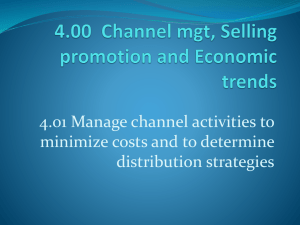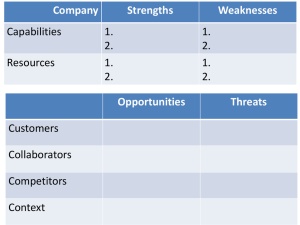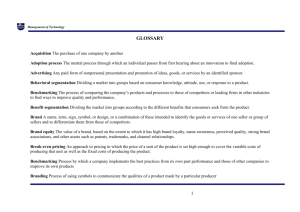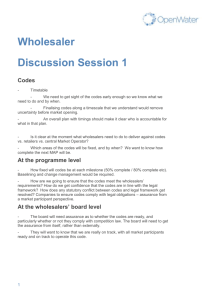Outline of Chapter 13
advertisement
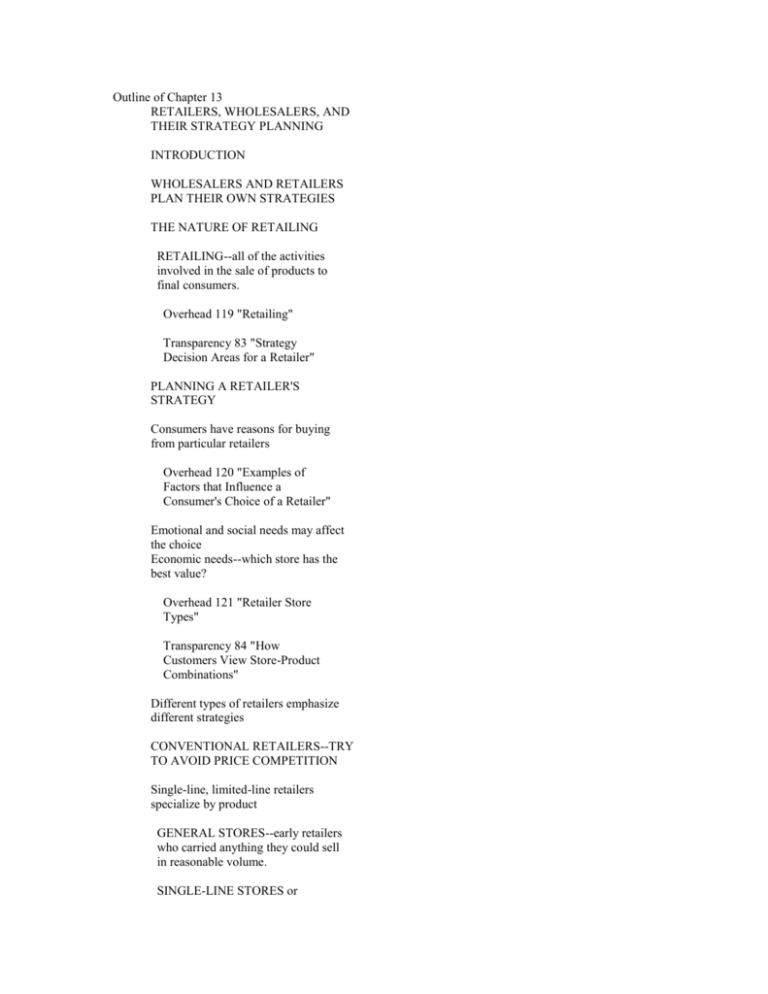
Outline of Chapter 13 RETAILERS, WHOLESALERS, AND THEIR STRATEGY PLANNING INTRODUCTION WHOLESALERS AND RETAILERS PLAN THEIR OWN STRATEGIES THE NATURE OF RETAILING RETAILING--all of the activities involved in the sale of products to final consumers. Overhead 119 "Retailing" Transparency 83 "Strategy Decision Areas for a Retailer" PLANNING A RETAILER'S STRATEGY Consumers have reasons for buying from particular retailers Overhead 120 "Examples of Factors that Influence a Consumer's Choice of a Retailer" Emotional and social needs may affect the choice Economic needs--which store has the best value? Overhead 121 "Retailer Store Types" Transparency 84 "How Customers View Store-Product Combinations" Different types of retailers emphasize different strategies CONVENTIONAL RETAILERS--TRY TO AVOID PRICE COMPETITION Single-line, limited-line retailers specialize by product GENERAL STORES--early retailers who carried anything they could sell in reasonable volume. SINGLE-LINE STORES or LIMITED-LINE STORES--stores that specialize in certain lines of related products rather than a wide assortment. Single-line, limited-line stores are being squeezed Transparency 85 (Exhibit 13-1) "Types of Retailers and the Nature of Their Offerings" EXPAND ASSORTMENT AND SERVICE--TO COMPETE AT A HIGH PRICE Specialty shops usually sell shopping products SPECIALTY SHOP--a type of conventional limited-line store--usually small and with a distinct "personality." Department stores combine many limited-line stores and specialty shops DEPARTMENT STORES--larger stores that are organized into many separate departments and offer many product lines. EVOLUTION OF MASS-MERCHANDISING RETAILERS Mass-merchandising is different than conventional retailing MASS-MERCHANDISING CONCEPT--the idea that retailers should offer low prices to get faster turnover and greater sales volumes--by appealing to larger markets. Overhead 122 "Mass-Merchandising Concept" Supermarkets started the move to mass-merchandising SUPERMARKETS--large stores specializing in groceries with self-service and wide assortments. Catalog showroom retailers preceded discount houses CATALOG SHOWROOM RETAILERS--stores that sell several lines out of a catalog and display showroom with backup inventories. Discount houses upset some conventional retailers DISCOUNT HOUSES--stores that sell "hard goods" (cameras, TVs, appliances) at substantial price cuts--to customers who go to discounter's low-rent store, pay cash, and take care of any service or repair problems themselves. Mass-merchandisers are more than discounters MASS-MERCHANDISERS--large, self-service stores with many departments that emphasize "soft goods" (housewares, clothing, and fabrics) and staples (like health and beauty aids) and selling on lower margins to get faster turnover. Supercenters meet all routine needs SUPERCENTERS (HYPERMARKETS)--very large stores that try to carry not only food and drug items, but all goods and services that the consumer purchases routinely. New mass-merchandising formats keep coming Single-line mass-merchandisers are coming on strong SOME RETAILERS FOCUS ON ADDED CONVENIENCE Convenience (food) stores must have the right assortment CONVENIENCE (FOOD) STORES--a convenience-oriented variation of the conventional limited-line food stores. Vending machines are convenient AUTOMATIC VENDING--selling and delivering products through vending machines. Door-to-door retailers--try to give personal attention DOOR-TO-DOOR SELLING--going directly to the consumer's home. Shop at home--with telephone, TV and direct-mail retailing TELEPHONE AND DIRECT-MAIL RETAILING--allow consumers to shop at home--usually placing orders by mail or a toll-free long distance telephone call and charging the purchase to a credit card. Put the catalog on cable TV or computer RETAILING ON THE INTERNET Overhead 123 "Retailing and the Internet" It's still in its infancy Product assortments are not limited by location Convenience takes on new meanings More or less information at the same time Lost in the "aisles" of the Internet The costs are still deceptive Competitive effects will influence other retailers RETAILING TYPES ARE EXPLAINED BY CONSUMER NEEDS FILLED Transparency 86 (Exhibit 13-2) "A Three-Dimensional View of the Market for Retail Facilities and the Probable Position of Some Present Offerings" WHY RETAILERS EVOLVE AND CHANGE The wheel of retailing keeps rolling WHEEL OF RETAILING THEORY--new types of retailers enter the market as low-status, low-margin, low-price operators and then--if successful--evolve into more conventional retailers offering more services with higher operating costs and higher prices. Scrambled merchandising--mixing product lines for higher profits SCRAMBLED MERCHANDISING--retailers carrying any product lines they think they can sell profitably. Overhead 124 "Examples of Scrambled Merchandising" Transparency 87 "Illustrative Gross Margins in Selected Retail Trades for Recent Years" Product life-cycle concept applies to retailer types too Transparency 88 (Exhibit 13-3) "Retailer Life Cycles--Timing and Years to Market Maturity" Ethical issues may arise RETAILER SIZE AND PROFITS But a few big retailers do most of the business Overhead 125 (Exhibit 13-4) "Distribution of Stores by Size and Share of Total U.S. Retail Sales" Overhead 126 "Retailer Size and Profits" Big chains are building market clout CORPORATE CHAIN--a firm that owns and manages more than one store-and often it's many. Independents form chains too COOPERATIVE CHAINS--retailer-sponsored groups--formed by independent retailers--to run their own buying organizations and conduct joint promotion efforts. VOLUNTARY CHAINS--wholesaler-sponsored groups that work with "independent" retailers. Franchisors form chains too FRANCHISE OPERATION--a franchisor develops a good marketing strategy, and the retail franchise holders carry out the strategy in their own units. Transparency 89 "Examples of Some Well-Known Franchise Operations" Overhead 127 "Franchise Operations" Overhead 128 "Location of Retail Facilities" DIFFERENCES IN RETAILING IN DIFFERENT NATIONS New ideas spread across countries Mass-merchandising requires mass markets Consumer cooperatives are popular in some countries Some countries block change Overhead 129 "Some Trends in Retailing" Overhead 130 "Some Trends in Wholesaling" WHAT IS A WHOLESALER? WHOLESALING--the activities of those persons or establishments that sell to retailers and other merchants, and/or to industrial, institutional, and commercial users, but who do not sell in large amounts to final consumers. WHOLESALERS--firms whose main function is providing wholesaling activities. WHOLESALING IS CHANGING WITH THE TIMES Producing profits, not chasing orders Progress--or fail Perhaps good-bye to some Is it an ethical issue? Survivors will need effective strategies WHOLESALERS ADD VALUE IN DIFFERENT WAYS Overhead 131 "What a Wholesaler Might Do for Customers" Overhead 132 "What a Wholesaler Might Do for Producer-Suppliers" Transparency 90 (Exhibit 13-5) "U.S. Wholesale Trade by Type of Wholesale Operation" Transparency 91 (Exhibit 13-6) "Types of Wholesalers" Transparency 92 "Wholesalers Provide Economies of Scale in Transporting and Storing" Manufacturers' sales branches are considered wholesalers MANUFACTURERS' SALES BRANCHES--separate warehouses that producers set up away from their factories. Overhead 133 "Manufacturers' Sales Branches" MERCHANT WHOLESALERS ARE THE MOST NUMEROUS MERCHANT WHOLESALERS--wholesalers who own (take title to) the products they sell. Overhead 134 "Merchant Wholesalers" Service wholesalers provide all the functions Overhead 135 "Full-Service Merchant Wholesalers" SERVICE WHOLESALERS-merchant wholesalers who provide all the wholesaling functions. GENERAL MERCHANDISE WHOLESALERS--service wholesalers who carry a wide variety of nonperishable items such as hardware, electrical supplies, plumbing supplies, furniture, drugs, cosmetics, and automobile equipment. SINGLE-LINE (OR GENERAL-LINE) WHOLESALERS--service wholesalers who carry a narrower line of merchandise than general merchandise wholesalers. SPECIALTY WHOLESALERS--service wholesalers who carry a very narrow range of products--and offer more information and service than other service wholesalers. Limited-function wholesalers provide some functions LIMITED-FUNCTION WHOLESALERS--merchant wholesalers who provide only some wholesaling functions. Overhead 136 "Some Limited-Function Merchant Wholesalers" Overhead 137 "Functions Provided by Different Types of Limited-Function Merchant Wholesalers" Cash-and-carry wholesalers want cash CASH-AND-CARRY WHOLESALERS--like service wholesalers--except that the customer must pay cash. Drop-shipper does not handle the products DROP-SHIPPERS--wholesalers who own (take title to) the products they sell--but do not actually handle, stock, or deliver them. Truck wholesalers deliver--at a cost TRUCK WHOLESALERS--wholesalers who specialize in delivering products that they stock in their own trucks. Rack jobbers sell hard-to-handle assortments RACK JOBBERS--specialize in hard-to-handle assortments of products that a retailer doesn't want to manage--and they often display them on their own wire racks. Catalog wholesalers reach outlying areas CATALOG WHOLESALERS--sell out of catalogs that may be distributed widely to smaller industrial customers or retailers who might not be called on by other middlemen. AGENT MIDDLEMEN ARE STRONG ON SELLING Overhead 138 "Agent Middlemen" They don't own the products AGENT MIDDLEMEN--wholesalers who do not own (take title to) the products they sell. They are important in international trade Overhead 139 "Functions Provided by Different Types of Agent Middlemen" Manufacturers' agents--free-wheeling sales reps MANUFACTURERS' AGENT--agent middleman who sells similar products for several noncompeting producers--for a commission on what is actually sold. Overhead 140 "Manufacturers' Agents" EXPORT AGENTS--manufacturers' agents who specialize in export trade. IMPORT AGENTS--manufacturers' agents who specialize in import trade. Brokers provide information BROKERS--agent middlemen who specialize in bringing buyers and sellers together. EXPORT OR IMPORT BROKERS--brokers who specialize in bringing together buyers and sellers from different countries. Overhead 141 "Brokers" Selling agents--almost marketing managers SELLING AGENTS--agent middlemen who take over the whole marketing job of producers--not just the selling function. COMBINATION EXPORT MANAGER--a blend of manufacturers' agent and selling agent--handling the entire export function for several producers of similar but noncompeting lines. Auction companies--speed up the sale AUCTION COMPANIES--agent middlemen who provide a place where buyers and sellers can come together and complete a transaction. WHAT WILL HAPPEN TO RETAILERS AND WHOLESALERS IN THE FUTURE? IDEAS ON USING COLOR TRANSPARENCIES OF ADS WITH CHAPTER 13 Transparency 156 (Procter & Gamble) "Our pre-built displays can help you cut costs. How much depends on how you handle them." Procter & Gamble Streamlined Display system holds down distribution costs and gives retailers help with merchandising. P&G picks brands and sizes that will sell fast in a particular retailer's store(s) and then loads them on a display pallet that is sent to the retailer as a single integrated unit. Transparency 157 (Procter & Gamble) "We'd like to clear up a little confusion for your shoppers. There, that's better." In-store merchandising makes P&G's new packaging for Crest apparent and useful. Transparency 162 (Diamond Crystal Specialty Foods) "Everything from soup to hazelnuts." Vending machine sales are very convenient and have grown rapidly. This growth represents an opportunity for Diamond Crystal because its array of products are designed to support firms that want to satisfy customers' needs through vending. Transparency 169 (DisplayOne-Menasha Corp.) "This is the only display that will get more attention in-store." DisplayOne gives producers help in creating special displays. The displays win support from retailers because they help with merchandising and in-store promotions. Transparency 177 (Rice Krispies Treats-Kellogg's) "Single and available." Vending machine sales are important in a number of product categories, including candy and other single serve snack foods like Kellogg's Rice Krispies Treats. Transparency 181 (Pet Team) "Finally, independent retailers can fight back!" In the competitive market for retail pet products, an independent retailer is usually at a disadvantage in competing against mass-merchandisers that offer lower prices. Pet Team uses selective distribution to reduce this problem. It's Healthy Harvest brand products are sold only through independents--so there is not direct price competition (on the same brand, at least) from mass-merchandisers. Transparency 188 (Grainger) "There's a lot more to EPACT than just changing lamps." Grainger is a catalog wholesaler providing a huge selection of products-including EPACT-approved lighting and equipment. Transparency 196 (Kent & Spiegel Direct) "There's only one buckwheat hull pillow with over $10.5 million in advertising behind it. Sobakawa Pillow." The objective of this trade ad to inform retailers about the advertising support for the Sobakawa buck wheat hull pillow and to persuade them to stock it--so consumers who want the pillow "won't be disappointed." A retailer might or might not find the message compelling--depending on the "fit" of the pillow with the retailer's target market, product mix, and expected profit margin. Transparency 197 (McCormick & Co) "The most complete sales and profit building program in the seafood business! Golden Dipt & Old Bay. We make selling seafood easy." All of the firms in a channel of distribution for a consumer product suffer if products don't sell at retail, so McCormick develops point-of-purchase sales promotion items, including special displays, that help retailers to be more successful in selling its Old Bay and Golden Dipt brands. Transparency 215 (Netcom Online Communication Services) "Open your business on the Internet with the #1 ranked Web hosting service provider." Many wholesalers and retailers--even very small ones--are establishing their own web sites so that they have a presence on the Internet. While there is uncertainty about exactly how Internet selling will develop in the future, firms that do not begin to prepare for the future are likely to be left in the dust by those that do. Transparency 218 (Zerex by Valvoline) "Buy low, sell higher." Grocery stores, drugstores, and convenience stores that don't routinely stock antifreeze might scramble their merchandise and carry it in early winter when the temperature starts to drop--especially if it offers profits margins that are greater than what might be possible with other seasonal products. PERSPECTIVES ON TEACHING CHAPTER 13--RETAILERS, WHOLESALERS, AND THEIR STRATEGY PLANNING It's useful to emphasize to students that middlemen--both retailers and wholesalers--should be viewed from two perspectives. First, middlemen should develop their own marketing strategies--focusing on specific target markets and developing their own marketing mixes. At the same time, middlemen are part of an overall channel system. Thus, it's important to see the role that middlemen play as specialists in channel systems--and to understand why they have changed as customer needs and overall channels have changed. Clearly, the two perspectives are closely related. Much of the retailer's or wholesaler's strategy is determined by the role that it plays in the overall channel. A theme throughout this chapter is to give students an understanding of how retailing and wholesaling are changing--and why the changes are taking place. Retailing is a visible and dynamic aspect of marketing. Wholesaling tends to be less visible and most students don't start out with intuition--from the customer's perspective--about the role it plays. However, the text works to overcome this gap. If students see and understand the changes taking place around them, they will be better able to identify new opportunities as they arise in the future. Clearly, some of the most dramatic changes taking place relate to technology, especially the move to selling over the Internet. This topic is developed in detail in the text for both retailing and wholesaling. In fact, the evolutionary perspective adopted in the chapter makes it easy to discuss Internet-based selling in class. In fact, the new section at the end of the chapter (which considers in some depth what might happen to retailers and wholesalers in the future as selling on the Internet becomes an even greater force in the economy) can provide the basis for a discussion that easily takes a whole class. The approach is simple. Get students talking about this future view, and then slowly begin to relate their comments and criticisms (some of which will be based on their own experiences of buying something over the Internet) back to the traditional topics considered earlier in the chapter. This is not a traditional way to cover this material, but it works well and generates good student involvement and interest. Some faculty prefer to focus primarily on retailing and to put less emphasis on wholesaling topics. Time considerations or other factors may argue for that approach, but the decision shouldn't be made lightly. Most students really do need to get a more realistic impression of what wholesaling involves and how it is evolving. It is perhaps not surprising that many students have the uninformed impression that wholesalers don't really provide anything of value either to their suppliers or their customers, and that most wholesalers simply add an additional layer of costs to the marketing process. To offset these misconceptions, this chapter considers the different types of functions (benefits) that wholesalers provide for their suppliers in the channel and to customers at the end of the channel. Wholesalers are adapting to and facilitating the changing retail landscape. It's also moving toward closer partnerships and ongoing relationships in business markets. In this chapter, there is substantial "institutional" description of the different types of retailers and wholesalers. The primary purpose of this is to show that widely varied types of middlemen have emerged to deal with different types of needs. Throughout the discussion, the focus is on the evolution of strategy. In class discussions, it is useful to regularly reinforce the idea that retailers and wholesalers succeed--indeed survive--only when they can add value and provide functions for suppliers or customers more efficiently and at lower cost than could be achieved if they were not there. As is the case at other levels of production and distribution in our market-driven economy, retailers and wholesalers who are not able to "add value" with their strategy have trouble staying in business. The chapter-opener example focuses on the role that a small California wholesaler (Freida Caplan) has played in opening up new market opportunities for products like kiwi and other exotic fruits and vegetables. A useful way to use this example is to juxtapose it with the Cooper Distributing example (on p. 368). Clearly, the chapter-opener example focuses primarily on a positive view of the relationship between a wholesaler and its suppliers and customers. By contrast, the Cooper Distributing case revisits the issue of channel conflict which was first introduced in depth in Chapter 11. Here again, it is useful to reinforce the notion that for wholesalers, as for producers and retailers, marketing strategy cannot be static. As markets, competition, and the marketing environment change, strategies must be revised and updated. To highlight that point, the instructor may want to revisit the Amazon.com case that introduces Chapter 11. The highlighted teaching example for this chapter (on page 375) focuses on a service called Industry.net that is provided by Information Handling Services (IHS). This example provides an excellent launching point for discussion of how the Internet is changing middlemen roles in many channels.




